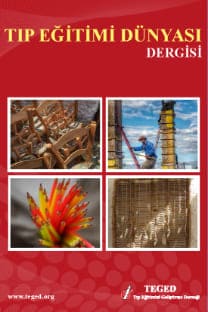İskelet Sistemi Anatomisi Eğitiminde Takıma Dayalı Öğrenme Yönteminin Uygulanması
Anatomi, Tıp Eğitimi, Takıma Dayalı Öğrenme
Human Skeletal Anatomy Education by Using Team-Based Learning Method
Anatomy, Medical Education, Team-Based Learning,
___
- 1. Altıntaş L, Alimoğlu MK. Takım Çalışmasına Dayalı Öğrenme. Turkiye Klin Med Educ - Spec Top. 2016;1(1):33–40.
- 2. Thompson BM, Schneider VF, Haidet P, Perkowski LC, Richards BF. Factors influencing implementation of team-based learning in health sciences education. Acad Med. 2007;82(10 SUPPL.).
- 3. Compton S, Kamei R, Cook S. The history and future of Team-Based Learning. Vol. 25, Proceedings of Singapore Healthcare. SAGE Publications Inc.; 2016. p. 3–4.
- 4. Vasan NS, DeFouw DO, Compton S. A survey of student perceptions of team-based learning in anatomy curriculum: Favorable views unrelated to grades. Anat Sci Educ [Internet]. 2009 Jul [cited 2020 Jan 30];2(4):150–5. Available from: http://doi.wiley.com/10.1002/ase.91
- 5. Vasan NS, Defouw DO, Compton S. Team-based learning in anatomy: An efficient, effective, and economical strategy. Anat Sci Educ. 2011 Nov;4(6):333–9.
- 6. Disorders R. MEDICAL FACULTY Acibadem Mehmet Ali Aydinlar University Booklet for TBL ,Musculoskeletal anatomy-upper extremity. 2020;
- 7. Michaelsen L, Peterson TO, Sweet M. Building learning teams: The key to harnessing the power of small groups in management education. In: The SAGE Handbook of Management Learning, Education and Development. SAGE Publications Inc.; 2009. p. 325–43.
- 8. Gayef A. Team based learning in medical education. Önder I, Beşoluk S, Çalişkan H, Masal E, editors. SHS Web Conf [Internet]. 2019 Aug 14 [cited 2020 Feb 4];66:01017. Available from: https://www.shs-conferences.org/10.1051/shsconf/20196601017
- 9. Sharma A, Janke KK, Larson A, Peter WS. Understanding the early effects of team-based learning on student accountability and engagement using a three session TBL pilot. Curr Pharm Teach Learn [Internet]. 2017;9(5):802–7. Available from: http://dx.doi.org/10.1016/j.cptl.2017.05.024
- 10. Yilmaz M. Öğrenme ve Bilgi İlişkisi Learning-Knowledge Relationship. Vol. 29, Cilt. 2009.
- 11. Altintas L, Altintas O, Caglar Y. Modified use of team-based learning in an ophthalmology course for fifthyear medical students. Am J Physiol - Adv Physiol Educ [Internet]. 2014 Mar [cited 2020 Feb 18];38(1):46–8. Available from: http://www.ncbi.nlm.nih.gov/pubmed/24585469
- 12. Letassy NA, Fugate SE, Medina MS, Stroup JS, Britton ML. INSTRUCTIONAL DESIGN AND ASSESSMENT Using Team-based Learning in an Endocrine Module Taught Across Two Campuses.
- ISSN: 1303-328X
- Yayın Aralığı: 3
- Başlangıç: 2000
- Yayıncı: Tıp Eğitimini Geliştirme Derneği
Tıp Fakültesi Dönem 1-2-3 Öğrencilerinin İletişim ve Empati Becerilerinin Analizi
Seyhan DEMİR KARABULUT, Hatice Yağmur ZENGİN, Rifat Vedat YILDIRIM, Zerrin YILMAZ ÇELİK
Yeşim GÜROL, Oğuz Can IŞIK, Levent ALTINTAŞ, Melike ŞAHİNER
Öğretim Tasarımı, Modelleri ve Program Geliştirmeyle İlişkisi
Yavuz Selim KIYAK, İrem BUDAKOĞLU, Özlem COŞKUN
İskelet Sistemi Anatomisi Eğitiminde Takıma Dayalı Öğrenme Yönteminin Uygulanması
Pelin İSMAİLOĞLU, Fatma KAHRAMAN, Mustafa AKTEKİN, Melike ŞAHİNER, Levent ALTINTAŞ
Sema OZAN, Özlem MİMAN, Cemal H GÜVERCİN, Zehra DEMİROĞLU UYANIKER
Öğrenci Bakış Açısıyla Probleme Dayalı Öğrenim
Hayriye Dilek AKDOGAN, Serpil VELİPAŞAOĞLU, Berna MUSAL
Sinem İNANICI, Galip YARDIMCI, Yeliz R. BİNATAMİR, Rozerin Göze YÜKSEL
Funda TAYFUN KÜPESİZ, Neslihan ANDIC, Melike SEZGİN EVİM, İbrahim EKER, Fergun AYDİN, Gülen TÜYSÜZ, Dilek GÜRLEK, Melek ISIK, Yesim OYMAK, Berna ATESAGAOGLU, Tugba BELGEMEN, İsil ERDOGAN, Utku AYGÜNEŞ, Gül İLHAN, Ersin TÖRET, Ayse AKİNCİ, Ozlem TUFEKCİ, Burcak TATLİ, Begum SİRİN, Başak ÜNVER KOLUMAN, Süheyla OCAK, Musta
Tıp Fakültesi Son Sınıf Öğrencilerinin Umutsuzluk Düzeylerinin Belirlenmesi
